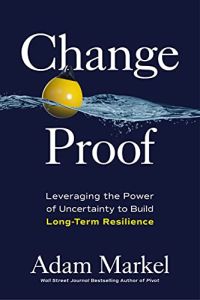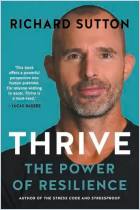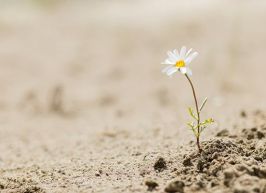Melden Sie sich bei getAbstract an, um die Zusammenfassung zu erhalten.

Melden Sie sich bei getAbstract an, um die Zusammenfassung zu erhalten.
Adam Markel
Change Proof
Leveraging the Power of Uncertainty to Build Long-term Resilience
McGraw-Hill, 2022
Was ist drin?
No matter how well you plan, things change. Adjust your approach to change by building resilience.
Recommendation
Plan B works when major changes come into your life – a new business, a failed relationship, health issues. However, in today’s volatile world, many changes don’t emerge clearly, but you must navigate the uncertainty and stress that inevitably follows. Resilience expert and best-selling author Adam Markel teaches you how to develop resilience to accept change and capitalize on its opportunities. He focuses on the “four realms” of the human character – body, mind, emotions and spirit – for building habits of resilience to help you thrive in the face of change.
Take-Aways
- Anticipate constant change in your life.
- Become resilient by adhering to three principles: “Pause, Ask, Choose.”
- Develop resilience when you don’t need it, so you have it when you do.
- Heed the signs of chronic stress and its impact on your physical well-being.
- Appreciate what you can control with mental resilience.
- Bolster your emotional resilience to prevent negativity from weighing you down.
- Practice spiritual resilience by appreciating the world around you and connecting with others.
- Resilient organizations thrive in the face of uncertainty.
Summary
Anticipate constant change in your life.
Constant change has become part of people’s lives. Uncertainty makes individuals feel anxious. In the past, often you could attribute stress and anxiety to major one-off events – a new job, a failed relationship or the onset of a health issue. You pivot with these changes; you create a plan B. Now in addition to these macro events, you constantly encounter small hiccups with your job, children and relationships. You cannot plan ahead for these micro pivots, nor can you avoid them. Cultivate a mind-set that flows with the uncertainty life offers and find opportunity in the disruption. To do this, you must develop resilience.
“Uncertainty has become the new certainty.”
Many people believe that being resilient means fighting off stress and bouncing back to how their lives were before the disruption. Yet resilience takes on new meaning in the face of constant change and uncertainty – even with positive change, since that, too, causes stress. Instead of resisting change and trying to reduce uncertainty, accept change as a constant to gain a renewed perspective on stress and to become change-proof.
Become resilient by adhering to three principles: “Pause, Ask, Choose.”
When caught in an ocean’s rip tide, your instinct tells you to fight for survival. However, the only way to survive is to stop fighting and let the current take you. Likewise, when facing unavoidable changes, focus your energy on swimming with them. You become resilient in a sea of uncertainty by adhering to three principles: “Pause, Ask, Choose.”
- Pause – When you stop fighting change, you gain the space you need to observe and learn. Acknowledge the energy you expend when fighting change. Like rebooting a computer, take a minute to reset.
- Ask – Reframe your situation, and reset your perspective. Ask yourself how you want to ride the change. Find your purpose.
- Choose – Take what you’ve learned and recover. In the midst of daily uncertainty, control your reaction to change and choose your next step. Resiliency doesn’t return you to your former self, but by choosing to move forward, you learn the essence of being change-proof.
Resilience does not ward off change, nor does it shield you from the pain change can cause. Instead, when you pause, ask and choose, you find your way through the stress change brings.
“Resilient people aren’t thermometers, which can only respond to the changing variables of temperature; rather, they’re thermostats, setting the temperature around them.”
It’s not entirely clear, why some people are more resilient than others. Certain individuals, for example, withstand horrendous situations – like war or abuse – and rise above it with seemingly little psychological impact or affliction. Yet studies cite certain factors that give people an edge regarding resilience, such as a healthy lifestyle, experience in handling major challenges, optimism, emotional flexibility, social connections and belief in a higher purpose.
Develop resilience when you don’t need it, so you have it when you do.
Most people seek balance between their professional and personal lives. Yet, like children on a playground seesaw, when the pairs balance, they stop moving. When they move up and down, they create harmony. The ocean teaches harmony in its constant movement as tides come and go, and shows you the fragility of the status quo. Leaders must create such harmony within their organizations to flow in the midst of the constant motion of business.
Like harmony, resilience is dynamic. It ebbs and flows as you weave in and out of uncertainty. When you develop resilience, you create harmony among the “four realms” of the human character: body, mind emotions and spirit. You view change and uncertainty through a different lens; you no longer see stress as bad, but as something to use to your advantage, because you learn to pause, ask and choose.
“This is how we perform resilience. We pause with our body. We ask with our minds and hearts. We choose with our spirit.”
Stress without rest leads to burnout; stress with rest leads to growth. For example, when leaders continually push their employees to perform at their maximum without giving them time to recover, workers will, eventually, underperform and burn out. If you regularly give them time to recoup, they achieve harmony and come back stronger.
People build resilience by adopting the daily foundational habits of pause, ask, choose. Your approach to stress determines your outcome, and when you build daily resilience habits, you become stronger.
Heed the signs of chronic stress and its impact on your physical well-being.
Chronic stress has a negative impact on performance as well as physical well-being. Sled dog owners, for example, must pause their dogs when running races before they tire to maintain top performance throughout the race; dogs will not pause on their own. Farmers must allow the soil to pause and rebuild its nutrients to maintain high yields over the long term. Humans, too, must pause to rest and recover. Yet many people believe that they constantly need to fight, to not give in, but this approach creates diminishing returns. You lose motivation, suffer from fatigue and withdraw from your circle of support. You no longer enjoy your passions, your activities, your accomplishments; these activities shift in your mind from aspirations to obligations.
“We’ve got to take the lesson from our sled dogs, who may not like it, but they’ve got to rest at the beginning, so they’ve got something left later.”
To withstand the physical toll of stress on the body, build resilience. Pause, even when you think you cannot. Build time to reset into your day, for you personally and for your organization. Exercise and good physical health builds resilience. Exercise reduces the risk of Alzheimer’s, improves mood and memory, and lowers stress levels. Building physical resilience creates a personal and professional culture designed for long-term performance. Learn to accept change as something positive. Use pauses to reflect on instilling healthy, productive habits.
Appreciate what you can control with mental resilience.
As you accept change as the new normal, you need not accept the worry that follows. You have a choice. Those who successfully leverage uncertainty control, not the inevitable change that comes their way, but how they respond to it. With mental resilience, you think your way through unexpected challenges and tasks. Mental resilience does not suggest you avoid thinking. Pause, however, to avoid any negative thought spiral that may take hold. Ask and reframe the situation.
“Mental resilience isn’t a life free from the twin wolves of worry and anxiety. It’s about harnessing our energy in creative ways.”
As a leader, when you learn to adapt and teach others to pivot with you, you instill resilience in yourself and your organization. The founders of the video game Glitch exemplify the power of asking. Facing sluggish sales, they pivoted. Rather than abandon what they had built, they examined it and extracted fresh, new elements of their software. They rebranded these components into Slack, a wildly popular messaging platform businesses use worldwide.
To develop mental resilience, examine your thoughts and challenge your negative or irrational beliefs. Turn your mind-set around and create opportunities that change offers. Challenge yourself to look for positivity and optimistic outcomes in the face of disruption. Develop this habit to channel stress and build mental resilience.
Bolster your emotional resilience and prevent negativity from weighing you down.
People think they want calm – the absence of conflict and disruption. But this does not always prove true. You often get an emotional boost when anticipating something new, much like the adrenaline rush surfers get when riding waves. Discouraging negativity in times of stress and preventing your mood from sinking calls for emotional resilience – the ability to handle the ups and downs of daily life. As with other types of resilience, the pause, ask, choose habit allows you to reflect on your emotions; performing rituals, such as meditation, helps provide calm when stress overwhelms you.
When your emotions spiral downward, try the “3-4 Method,” during which you use your breathing to pause, ask, choose:
- Inhale – Do you like feeling this way?
- Hold – Do you want to let it go?
- Hold – Are you willing to let it go?
- Exhale – When will you let it go?
Leaders model emotional resilience within their organizations by being transparent. Be clear about what you want, and what you and your organization need. Personal emotional resilience relies on telling the truth – to yourself and to others. Leaders and organizations must address problems that hinder production but may be swept aside in the bustle of daily activity. Leaders who embrace these struggles and make the tough choice of transparency will find long-term support through resilient work relationships anchored in trust.
Practice spiritual resilience by appreciating the world around you and connecting with others.
Your spirit grounds you and carries you through your successes and failures. To grow your spiritual resilience, pause, reflect and connect with others. For example, those who show resilience in the wake of a traumatic event share characteristics that help them survive, and in many cases, thrive. These people:
- Appreciate life and see its possibilities.
- Improve relationships with others and connect with them spiritually.
- Demonstrate personal strength.
When uncertainty hits, many people naturally pull inward. But to find your spiritual resilience, you must connect with others. Focus on what you have, not on what you don’t have; focus on a future endeavor; and believe things will work out. These practices, when repeated, create a habit of spiritual resilience that pulls you forward and gives you inspiration.
“The mind-set of gratitude puts us exactly in line with resilience because we take the world as it comes to us, as it is, instead trying to make it correspond to every “must” that churns through our heads and hearts.”
Invoke your spiritual resilience by practicing daily gratitude, recognizing all the good things and relationships in your life. Gratitude doesn’t ignore the hiccups or struggles. A daily gratitude practice cultivates a mind-set that better navigates uncertainty.
Resilient organizations thrive in the face of uncertainty.
Develop a culture of resilience in your organization to spur creativity and activate the four realms. Pause to reframe your circumstances; ask questions to reset perspective, and choose to recover and move forward. Use your imagination to envision the future you want for your team and your organization.
“You can’t stop the rain, but you can make sure you’ve got the best and the biggest umbrella.”
Walt Disney, for example, used his imagination to create the iconic characters that continue to resonate today. He embedded his philosophy of continual reinvention in the culture of the Disney organization. Disney’s employees knew they need not avoid risk or fear failure but could embrace change and grow with it. When you recognize the inevitability of change, you creatively lead your organization with resilience.
Strategic foresight helps you adopt creative imagination and thrive in turbulent times. Set goals – the “what” in your future – and systems – the “how”– to get there. The systems, or habits, you establish provide the creative license your organization needs to make decisions toward achieving goals and to imagine future success.
About the Author
Adam Markel is the co-founder of More Love Media, a professional training and coaching company that helps build work cultures of inspiration and resilience. He also wrote the bestseller Pivot: The Art and Science of Reinventing Your Career and Life.
This document is restricted to personal use only.



















Comment on this summary